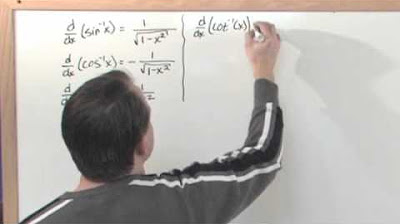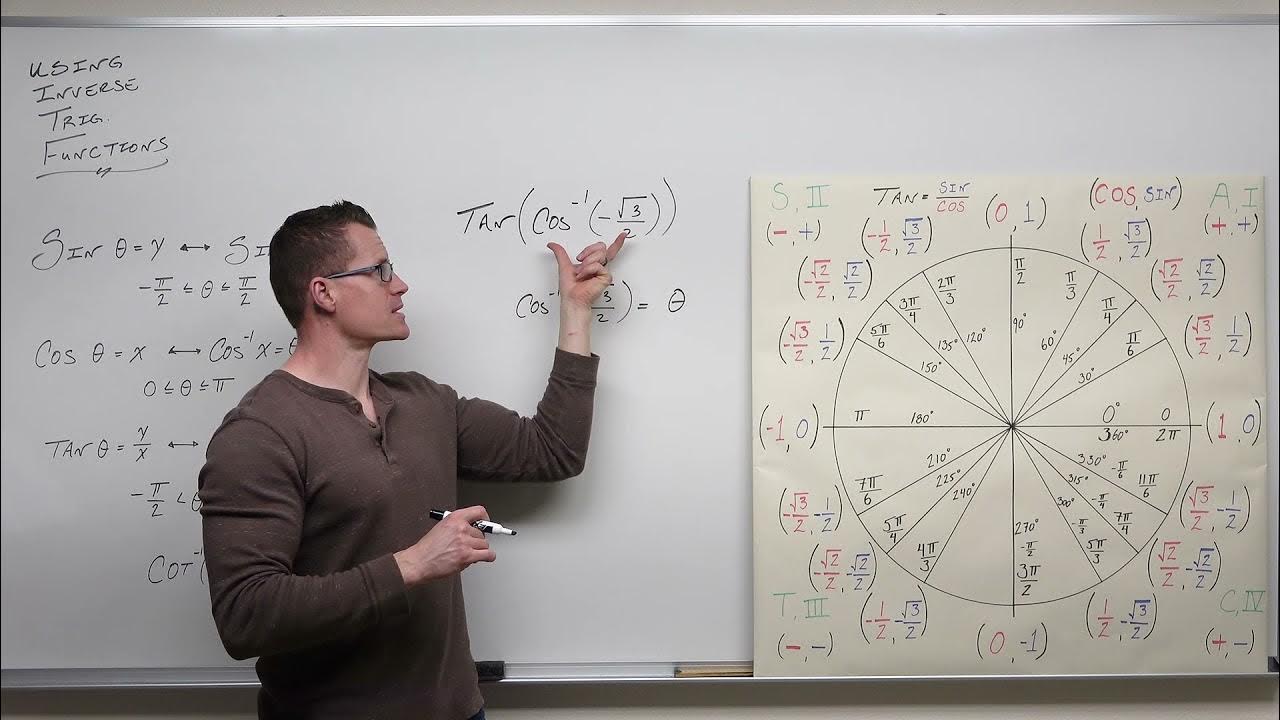Inverse Trig Functions and Differentiation
TLDRThis educational video offers a comprehensive review of inverse trigonometric functions, focusing on their derivatives. It begins with an explanation of the restricted ranges for arcsine, arccosine, and arctangent, followed by practical examples of finding angles using these functions. The instructor then delves into deriving the formulas for the derivatives of arcsine and arctangent using implicit differentiation, providing step-by-step guidance. The video also covers the derivative of arccosine, which is the negative of the arcsine derivative. Finally, the script includes examples of applying these derivatives using the chain rule, making it an informative resource for students preparing for exams like the AP Calculus.
Takeaways
- 📚 The video provides a review of inverse trigonometric functions and their derivatives, which are essential topics in pre-calculus.
- 📐 The script explains how to find the value of inverse trigonometric functions like arcsine and arccosine by drawing triangles in the correct quadrants and using the Pythagorean theorem.
- 🔍 The range for arcsine is from 0 to π, and for arctan, it's from π/2 to -π/2, which is important for understanding the correct quadrant to draw the triangle.
- 📉 The script demonstrates how to find the arcsine of -1/2 by drawing a triangle in the fourth quadrant and identifying the angle as -π/6.
- 📈 The video also covers how to find the arccosine of a negative value by drawing a triangle in quadrant 2 and identifying the angle as 3π/4.
- 🔑 The concept of implicit differentiation is introduced to derive the formula for the derivative of arcsine, which is y' = 1/(cosine(y)).
- 🧭 To express the derivative of arcsine in terms of x, the cosine of arcsine(x) is found to be √(1 - x^2), leading to the derivative formula y' = 1/√(1 - x^2).
- 📝 The script explains the process of deriving the derivative of arctan using similar methods, resulting in the formula y' = 1/(1 + x^2).
- 🔄 The chain rule is applied when differentiating composite functions involving inverse trigonometric functions, such as arcsine and arctan of a variable.
- 📚 The video emphasizes the importance of memorizing the derivative formulas for arcsine and arctan, especially for exams like the AP exam.
- 📘 Finally, the script provides examples of how to apply these derivative formulas to functions like f(x) = arcsin(2x) and f(x) = arctan(3x), using the chain rule when necessary.
Q & A
What is the restricted range for the arcsine function?
-The restricted range for the arcsine function is from 0 to Pi, or in other terms, from 0 to π.
What is the range for the arctangent function?
-The range for the arctangent function is from -π/2 to π/2.
How do you find the arcsine of -1/2?
-To find the arcsine of -1/2, you draw a triangle in the fourth quadrant, where the opposite side is -1 and the hypotenuse is 2, resulting in an angle of -π/6.
Why is the range of arctangent not over quadrant 3?
-The range of arctangent is not over quadrant 3 because the arctangent function does not have a restricted range in that quadrant.
What is the derivative of the arcsine function with respect to x?
-The derivative of the arcsine function with respect to x is 1 / √(1 - x^2).
How do you derive the formula for the derivative of arcsine using implicit differentiation?
-You start by setting y = arcsine(x), rewrite it as x = sin(y), differentiate both sides with respect to x, and solve for dy/dx to get 1 / √(1 - x^2).
What is the derivative of the arctangent function with respect to x?
-The derivative of the arctangent function with respect to x is 1 / (1 + x^2).
How do you find the derivative of a function that involves arcsine or arctangent using the chain rule?
-You multiply the derivative of the inner function (arcsine or arctangent) by the derivative of the outer function (the function inside arcsine or arctangent).
What is the derivative of the function f(x) = arcsine(2x)?
-The derivative of f(x) = arcsine(2x) is 2 / √(1 - (2x)^2).
What is the derivative of the function f(x) = arctangent(3x)?
-The derivative of f(x) = arctangent(3x) is 3 / (1 + (3x)^2).
How do you find the derivative of a function that involves the cosine of an arcsine?
-You use the derivative of the cosine function, which is -sine, and multiply it by the derivative of the inner function (arcsine), which is 3 / √(1 - (3x)^2).
Outlines
📚 Review of Inverse Trigonometric Functions and Derivatives
This paragraph provides a review of inverse trigonometric functions, focusing on how to determine their derivatives. It starts with a discussion of the restricted ranges for arcsine, arccosine, and arctangent, using the example of finding the arccosecant of -1/2 by drawing a triangle in the correct quadrant and applying the Pythagorean theorem to find the angle. The paragraph also covers the process of finding the arccosine of a value by drawing a triangle in quadrant 2 and rationalizing the denominator to simplify the calculation. The speaker emphasizes the importance of understanding these concepts and the ability to use a calculator for non-special triangles. The paragraph concludes with an introduction to deriving the formula for the derivative of arccosecant using implicit differentiation.
🔍 Deriving Derivatives of Inverse Trigonometric Functions
The second paragraph delves into the process of deriving the derivatives of inverse trigonometric functions, specifically focusing on arccosecant and arctangent. The speaker uses implicit differentiation to derive the formula for the derivative of arccosecant, expressing it in terms of the cosine of the angle. The paragraph continues with a similar approach for arctangent, finding its derivative in terms of the secant squared of the angle. The speaker simplifies the expressions by relating them back to the original function's input variable, X. The paragraph also covers the chain rule application when differentiating composite functions involving inverse trigonometric functions, providing formulas for the derivatives of arcsine and arctangent in terms of their inside functions. The speaker concludes with examples of applying these derivatives to functions of the form f(x) = arcsine(2x) and f(x) = arctangent(3x), and a brief mention of the derivative of arccosine as the negative of the arcsine derivative.
Mindmap
Keywords
💡Inverse Trigonometric Functions
💡Derivatives
💡Arcsine
💡Arctangent
💡Restricted Range
💡Pythagorean Theorem
💡Implicit Differentiation
💡Chain Rule
💡Cosine
💡Tangent
💡Rationalize the Denominator
Highlights
Introduction to inverse trigonometric functions and their derivatives.
Explaining the restricted range for arccosine and arcsine/arc tangent.
Demonstration of finding the arcsine of -1/2 using a triangle in the fourth quadrant.
Use of the Pythagorean theorem to solve for the sides of the triangle.
Explanation of the negative angle in the context of the fourth quadrant.
Clarification on the non-applicability of arcsine in quadrant 3 despite the negative sine value.
Derivation of the derivative of arcsine using implicit differentiation.
Conversion of the arcsine relationship into a solvable equation for the derivative.
Finding the derivative of arcsine in terms of the original function argument.
Derivation of the derivative of arctan using a similar approach to arcsine.
Explanation of the secant squared in the context of the arctan derivative.
Presentation of the formulas for the derivatives of arcsine and arctan.
Introduction of the derivative formula for arccosine as the negative of arcsine.
Application of the chain rule to find the derivative of a composite function involving arcsine.
Application of the chain rule to find the derivative of a composite function involving arctan.
Example of using the chain rule with the derivative of cosine of arcsine.
Conclusion emphasizing the importance of knowing the derivatives for exams.
Transcripts
Browse More Related Video

Derivatives of Inverse Trigonometric Functions

Take Derivatives of Inverse Trig Functions (ArcSin, ArcCos) - [2]

Lesson 2 - Derivatives Of Inverse Trig Functions (Calculus 2 Tutor)

Calculus - Find the derivative of inverse trigonometric functions

Calculus AB Homework 3.6 Derivatives of Inverses

An Indepth Look at Using Inverse Trig Functions (Precalculus - Trigonometry 21)
5.0 / 5 (0 votes)
Thanks for rating: